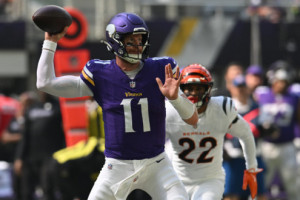NFL Best Ball Theory: Understanding Tiers

Earlier this week, Mike Beers expanded on the topic of roster construction, specifically highlighting how to treat the quarterback and tight end positions (also called “the onesies”) in your Draft Best Ball leagues.
Exercising his recommendations with your rosters is highly recommended, and Mike provides excellent guidelines with respect to early / mid / late ADP.
How do we best determine what early, mid, and late mean, however? Allow me to show you a simple method.
Editor’s Note: Use promo code “GRINDERS” when you sign up for Draft and get a 100% deposit bonus up to $600 and THREE months of RotoGrinders Draft Premium content!
What Are Tiers?
Simply, tiers are natural gulfs that develop between groups of players (typically within a position) during the course of a draft season. These separations are generally created by the crowd of drafters through their perception of how players will perform in an upcoming season. To provide a visual example, I’ve taken QB ADP data from our Draft Best Ball ADP page (it’s FREE!) and manipulated it to show how tiers have already developed in just two short weeks.

Table 1 – Recent Draft Best Ball ADP data for QBs dissected into tiers
With the divisions in place, we see how the crowd has created natural clusters at the QB position. Generally, I mark the end of a tier when the next player is roughly a round (12 picks) behind in ADP. In some cases, I will use a percentage that scales as the draft goes into the later rounds (i.e. 20% ADP drop early vs 5% ADP drop late) to determine boundaries.
How Do I Action This?
Avoid Unforced Errors
If we know where each step-down occurs for every position group, we can monitor our upcoming picks (up to three rounds ahead, in some cases) and determine if we should take a desired player/position at the leading end of the draft distribution curve. Why do this? We must avoid unforced errors that cause us to draft non-desirable assets at or above value because we missed a “window.”
For a practical example, envision that we’ve decided to run a Mid + Late QB draft strategy in a particular Best Ball draft. We’ve determined that for us to implement this strategy successfully, we should acquire two QBs from Tier 5 and one QB from Tier 6. We notice that a mini-run on QBs has pushed the available player pool down to Carson Wentz, and reason that we should probably commit our next two picks to QB to adhere to our plan. If we decide to wait another round, however, it’s entirely possible that our plan blows up in our face and we’re forced to run with Alex Smith, Brian Hoyer, and Mike Glennon as our three QBs. Not a savory option.
Drive Behavior
Another phenomenon created by tiers involves gamesmanship (some may call it sociopathy), perceived scarcity, and driving your opponents into uncomfortable decisions. I know you’re a budding sociopath because you’re immediately asking how to implement this in your drafts. This strategy typically involves picks near the turns (in 12-man drafts, the 1, 2, 11, and 12 slots) where you can take two players from a particular position group in succession. If timed correctly with the right group of drafters, you can force positional runs within a tier that allow other positions to fall down draft boards and gain value against their ADP.

To demonstrate, we’ll revisit the 2x Mid + Late QB example above. In this version of the example, however, we’re about to draft 13.10 and 14.02. We’ve recognized that a few other drafters are also waiting on QB. Here, it makes sense to go QB with back-to-back picks (Wentz + Bortles) to adhere to strategy, but we are also likely to drive a QB run between 14.02 and 15.10, when we pick again.
In creating a positional run with back-to-back picks, we also create access to players / tiers that might not have been available otherwise. This is how we put positional tiers to work.
Wrapping Up
Remember that your personal player and position values / tiers will frequently conflict with the crowd. Use this to your advantage when applying the two principles discussed above.
If you’d like to reference draft data similar to the RotoGrinders Draft Best Ball ADP page, I recommend checking out similar data from MyFantasyLeague MFL10 drafts as a reasonable “go-by” for your upcoming Best Ball drafts.
Why wait, though? Have a go at Draft’s new Best Ball format armed with your new knowledge today!
If you’re new to Draft, be sure to use promo code “GRINDERS” and receive a bonus on your first deposit.